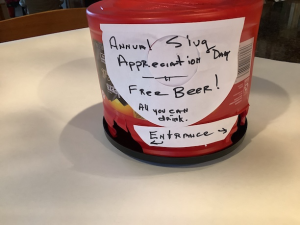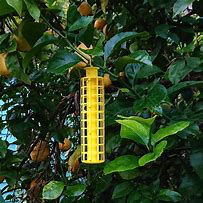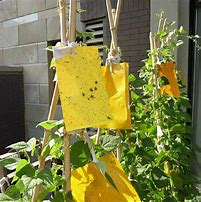Beer Traps
- (“What would become of the garden if the gardener treated...the slugs...as he would like to be treated if he were in their place”? — Thomas Huxley)
- The most simple beer traps are just a plastic drinking cup, sunk partly into the soil and filled part way up with beer.
- SInce it’s the yeast in the beer that’s the chief attractant, you can get away with the cheap stuff.
- A variation on the cup sunk in the soil is to build a shelter to keep the rain from diluting the beer.
- Of course, you could just mix yeast and water and use that, but the alcohol probably finishes them off more quickly than just drowning them. [Unverified assertion.]
- It’s important to check the traps frequently and empty the contents — beer, dead slugs and all — onto the ground away from your bed.
- If the traps aren’t emptied frequently they’ll develop into a moldy, smelly, thoroughly nasty sludge.


Commercially produced slug traps.
- Depending on the quantity, you can purchase these for about $5 apiece.
- On the other hand, you can produce you own by — for example — turning over an empty coffee container and cutting access holes in the rim.
- The cup of beer goes in the middle.


Sticky traps.
- These can catch many kinds of small insects including aphids, flies, flea beetles, and whiteflies.
- The caution to note is that these are another “broad spectrum” insect control; they don’t discriminate between harmful and beneficial insects.
- Sticky traps can be made from cards, cups or other objects coated with a sticky substance.
- Commercially available Tangle Trap is great because it’s weatherproof, but you will snare plenty of little victims with petroleum jelly or any thick syrup as a sticky coating for your homemade traps.
Colors make a difference.
- A wide variety of insects are attracted to the color yellow, including flies, flea beetles, and cucumber beetles.




- (WARNING: bees are also attracted to the color yellow.
- Check your traps frequently and remove them if you’re catching too many bees.)
- Some aphids prefer spring green, and thrips are drawn to the color blue.
- You can paint homemade sticky traps the color you want before applying a sticky coating.
- Install any hanging hooks or hardware in your trap before you get out the sticky stuff.
- The best place to set your trap is under your plant. This allows the trap to catch pests as they approach, if they fall off the plant, or if they land on the trap, attracted by the color or scent.
